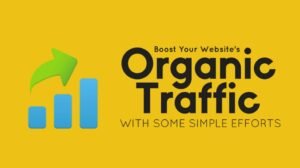Creating a successful SEO strategy is essential for improving your website’s visibility in search engine results and attracting organic traffic. In this article, we will guide you through the process of creating and executing an effective SEO strategy in eight simple steps. Let’s get started!
Step 1: Evaluate Your Current SEO Performance

To begin, it’s crucial to benchmark your current SEO performance. This involves analyzing your organic traffic, keyword rankings, and backlinks. By understanding your site’s current performance, you can set realistic goals and track your progress effectively.
Organic Traffic

Organic traffic refers to the number of visitors that come to your website through non-paid search results. You can use tools like Google Analytics or SEO platforms such as Semrush to determine your current organic traffic. For example, by using Semrush’s Domain Overview tool, you can discover the monthly organic search traffic for your website.
Keyword Rankings

Keyword rankings indicate how well your website ranks in search results for specific keywords. Higher-ranking pages receive more organic search traffic. You can find your keyword rankings using tools like Semrush’s Organic Search Traffic screen. Identify the top organic keywords that drive traffic to your site and take note of their positions and search volumes.
Backlinks

Backlinks play a crucial role in SEO. They are links from external websites that point to your site. Websites with a higher number of backlinks tend to have better organic search rankings. Use tools like Semrush’s Backlink Analytics to analyze your backlink profile and identify the number of referring domains and backlinks to your site.
Step 2: Analyze Your Competitors’ SEO Strategies

Analyzing your competitors’ SEO strategies can provide valuable insights and help you identify effective tactics to implement in your strategy. Here’s how to do it:
Identify Your Competitors
Start by identifying your main SEO competitors. These are the websites that are competing for the same keywords in organic search. Tools like Semrush’s Organic Research can help you find your top organic competitors based on shared keywords and monthly traffic.
Find Your Competitors’ Valuable Keywords
Identify valuable keywords that your competitors currently rank for, but you don’t. These keywords present opportunities for you to capture more traffic. Use tools like Semrush’s Keyword Gap tool to compare your domain with your competitors’ domains and find overlapping keywords. Take note of the top five keyword opportunities.
Audit Your Competitors’ Backlinks

Backlinks are crucial for SEO success. Conduct a backlink gap audit to identify websites that link to your competitors but not to you. These websites may be willing to link to your content if it provides more value than your competitor’s content. Use tools like Semrush’s Backlink Gap to compare your backlink profile with your competitors’ profiles and find potential linking opportunities.
Step 3: Set Your Goals and KPIs
Setting goals and key performance indicators (KPIs) is vital for evaluating the success of your SEO strategy. Your goals should align with your overall business objectives, and your KPIs should be measurable. Here are five important KPIs to track:
- Organic Traffic: Monitor the number of visitors coming to your site through organic search.
- Keyword Rankings: Track your website’s rankings for target keywords.
- Backlinks: Measure the number of quality backlinks pointing to your site.
- Average CTR (Click-through Rate): Calculate the percentage of people who click on your site after seeing it in search results.
- Coverage Issues: Identify and address any issues that prevent search engines from properly indexing your website.
“At Brand Donut, we offer our expert SEO services in Tampa, Miami, and Sacramento. Whether you need SEO services in Tampa, Miami SEO services, or Sacramento SEO services, we’ve got you covered. Our team of professionals is dedicated to helping businesses in these areas improve their online visibility and attract more customers. With tailored strategies and effective optimization techniques, we can help your business thrive in the digital landscape. Trust Brand Donut for all your SEO needs in Tampa, Miami, and Sacramento.”
Step 4: Perform Keyword Research
Keyword research is crucial for understanding the search intent of your target audience and optimizing your content accordingly. Use tools like Semrush’s Keyword Magic Tool or Google Keyword Planner to identify relevant keywords with high search volumes and low competition. Incorporate these keywords strategically into your content to improve your search rankings.
Step 5: Optimize On-Page Elements

Optimizing your on-page elements is essential for improving your website’s visibility in search results. Focus on optimizing your page titles, meta descriptions, headings, and URL structures. Ensure that your content is relevant, well-structured, and includes your target keywords naturally.
Step 6: Create High-Quality Content

High-quality content is key to attracting organic traffic and engaging your audience. Develop informative, valuable, and shareable content that aligns with your target audience’s interests and addresses their needs. Incorporate your target keywords naturally within your content and aim to provide the best answer or solution to users’ queries.
Step 7: Build Quality Backlinks
Building quality backlinks from authoritative websites is crucial for improving your search rankings. Focus on creating valuable content that other websites would want to link to. Implement outreach strategies to connect with relevant websites and request backlinks. Guest blogging, content partnerships, and influencer collaborations are effective tactics for building backlinks.
Step 8: Track, Analyze, and Adjust

Continuously track and analyze the performance of your SEO strategy using tools like Semrush’s Position Tracking and Google Analytics. Monitor your organic traffic, keyword rankings, backlinks, and other relevant metrics. Identify areas of improvement and make necessary adjustments to your strategy. SEO is an ongoing process, so staying updated and adapting to changes in algorithms and trends is crucial for long-term success.
By following these eight steps, you can create and execute an effective SEO strategy that improves your website’s visibility and drives organic traffic. Remember to regularly evaluate your performance, analyze your competitors, and adapt your strategy to stay ahead in the ever-evolving world of SEO.
People also ask:
1. What is an SEO strategy?
An SEO strategy is a plan that outlines the steps and techniques used to optimize a website and its content to improve visibility in search engine results and attract organic traffic.
2. Why is an SEO strategy important?
An SEO strategy is important because it helps businesses increase their online visibility, drive targeted traffic to their websites, and ultimately improve their online presence and reach their target audience.
3. How can I benchmark my current SEO performance?
To benchmark your current SEO performance, you can analyze your organic traffic, keyword rankings, and backlink profile. Tools like Google Analytics and SEO platforms such as Semrush can provide valuable insights for this analysis.
4. What does organic traffic mean?
Organic traffic refers to the number of visitors who come to your website through non-paid (organic) search engine results. It indicates the number of people who find your website naturally, without clicking on paid advertisements.
5. How can I find my current organic traffic?
You can find your current organic traffic by using tools like Google Analytics or SEO platforms such as Semrush. These tools provide data on the number of visitors coming to your website from organic search results.
6. Why are keyword rankings important?
Keyword rankings are important because they determine where your website appears in search engine results for specific keywords. Higher rankings lead to increased visibility and more organic traffic.
7. How can I find my keyword rankings?
You can find your keyword rankings by using tools like Semrush’s Organic Search Traffic screen. It allows you to see the keywords you rank for, your ranking position for each keyword, and the search volume associated with those keywords.
8. What are backlinks?
Backlinks are links from external websites that point to your website. They are important for SEO because search engines consider them as votes of confidence and use them to determine the credibility and relevance of your website.
9. Why are backlinks important for SEO?
Backlinks are important for SEO because they signal to search engines that your website is reputable and trustworthy. Websites with high-quality backlinks tend to rank higher in search results.
10. How can I check my backlink profile?
You can check your backlink profile using tools like Semrush’s Backlink Analytics. It provides information about the number of referring domains, backlinks, and other important metrics related to your backlink profile.
11. How can I analyze my competitors’ SEO strategies?
You can analyze your competitors’ SEO strategies by identifying your main SEO competitors and using tools like Semrush’s Organic Research. This will help you understand their keyword rankings, backlink profiles, and other tactics they are using to improve their search visibility.
12. Why is setting goals and KPIs important for an SEO strategy?
Setting goals and key performance indicators (KPIs) is important for an SEO strategy because they provide a measurable way to track progress and evaluate the success of your efforts. Goals and KPIs help you stay focused and aligned with your overall business objectives.
13. What are some important SEO KPIs to track?
Some important SEO KPIs to track include organic traffic, keyword rankings, backlinks, average click-through rate (CTR), and coverage issues. These metrics provide insights into the performance and effectiveness of your SEO strategy.
14. How can keyword research help in an SEO strategy?
Keyword research helps in an SEO strategy by providing insights into the search terms and phrases that people use to find information related to your business. It helps you understand user intent and optimize your content accordingly.
15. What tools can I use for keyword research?
There are several tools you can use for keyword research, such as Semrush’s Keyword Magic Tool, Google Keyword Planner, Ahrefs’ Keyword Explorer, and Moz’s Keyword Explorer. These tools provide data on search volumes, keyword difficulty, and related keywords.
16. What is on-page optimization?
On-page optimization refers to the process of optimizing the content and HTML source code of individual web pages to improve their visibility in search engine results. It involves optimizing elements like page titles, meta descriptions, headings, and URL structures.
17. How can I optimize my on-page elements?
To optimize your on-page elements, you should ensure that your page titles, meta descriptions, headings, and URL structures are relevant, descriptive, and contain your target keywords. It’s important to make these elements user-friendly and appealing to both search engines and users.
18. Why is high-quality content important for SEO?
High-quality content is important for SEO because it attracts and engages users, encourages them to spend more time on your website, and increases the likelihood of them sharing and linking to your content. Search engines value high-quality content and rank it higher in search results.
19. How can I create high-quality content?
To create high-quality content, you should focus on providing valuable and relevant information to your target audience. Conduct thorough research, use reliable sources, and ensure that your content is well-structured, easy to read, and free of errors. Incorporate your target keywords naturally and aim to answer users’ questions or solve their problems effectively.
20. What is link building?
Link building is the process of acquiring backlinks from other websites to your own. It involves outreach, content creation, and relationship building to earn links from reputable and relevant sources. Link building is an essential part of SEO as it helps to improve your website’s authority and visibility in search engine results.
21. How can I build quality backlinks?
To build quality backlinks, you can focus on creating high-quality content that other websites would find valuable and worth linking to. You can also engage in guest blogging, content collaborations, and outreach campaigns to connect with relevant websites and request backlinks. Building relationships with influencers and industry experts can also lead to valuable backlink opportunities.
22. How can I track the performance of my SEO strategy?
You can track the performance of your SEO strategy using tools like Semrush’s Position Tracking, Google Analytics, and other SEO platforms. These tools provide data on organic traffic, keyword rankings, backlinks, and other relevant metrics to help you evaluate the effectiveness of your strategy.
23. How often should I analyze my SEO performance?
It is recommended to analyze your SEO performance regularly. Depending on the size and complexity of your website, you can conduct monthly or quarterly reviews to track progress, identify trends, and make necessary adjustments to your strategy.
24. How can I stay updated with SEO trends and changes?
To stay updated with SEO trends and changes, you can follow reputable industry blogs, attend webinars and conferences, and engage in online communities dedicated to SEO. Following search engine algorithm updates and staying informed about new SEO techniques and best practices will help you adapt your strategy accordingly.
25. Is SEO a one-time process?
No, SEO is not a one-time process. It requires ongoing monitoring, optimization, and adaptation to stay competitive in search engine rankings. SEO is a continuous effort that evolves along with search engine algorithms, user behavior, and industry trends.
26. How long does it take to see results from an SEO strategy?
The time it takes to see results from an SEO strategy can vary depending on various factors such as the competitiveness of your industry, the quality of your website, the effectiveness of your optimization efforts, and the consistency of your SEO activities. Generally, it takes several months to start seeing significant improvements in organic rankings and traffic.
27. Should I focus on organic traffic or paid advertising?
Both organic traffic and paid advertising have their advantages. Organic traffic is free and sustainable, but it takes time and effort to build. Paid advertising can provide immediate results but requires a budget. A balanced approach that combines both organic and paid strategies can often yield the best results.
28. Can I do SEO on my own, or do I need to hire an expert?
You can do SEO on your own if you have the time, resources, and knowledge to implement effective strategies. However, SEO can be complex and time-consuming, so hiring an SEO expert or agency can provide you with specialized expertise and save you valuable time.
29. How often should I update my SEO strategy?
Your SEO strategy should be reviewed and updated regularly to adapt to changes in search engine algorithms, industry trends, and your business goals. It’s recommended to conduct a thorough review of your strategy at least annually, but you may need to make adjustments more frequently based on the evolving SEO landscape.
30. What are some common SEO mistakes to avoid?
Common SEO mistakes to avoid include keyword stuffing, using unethical practices (such as buying links), neglecting mobile optimization, ignoring user experience, and not regularly updating and optimizing your content. It’s important to stay informed about SEO best practices and follow ethical guidelines to ensure long-term success.



